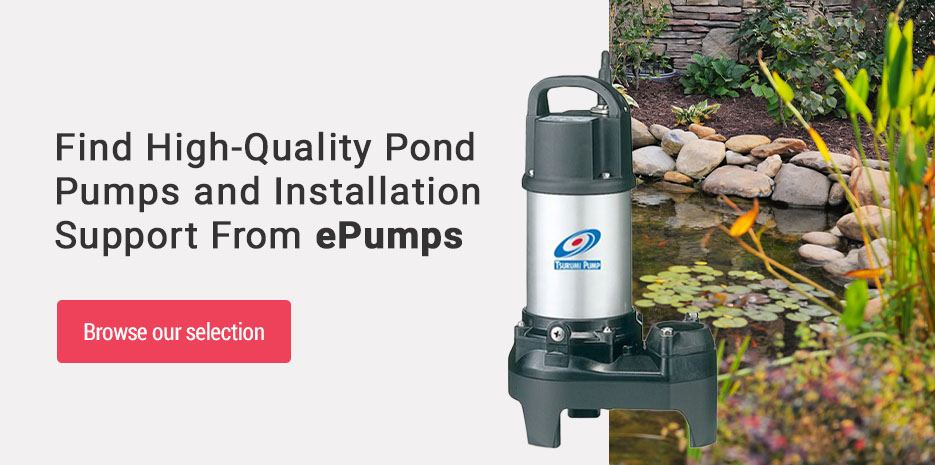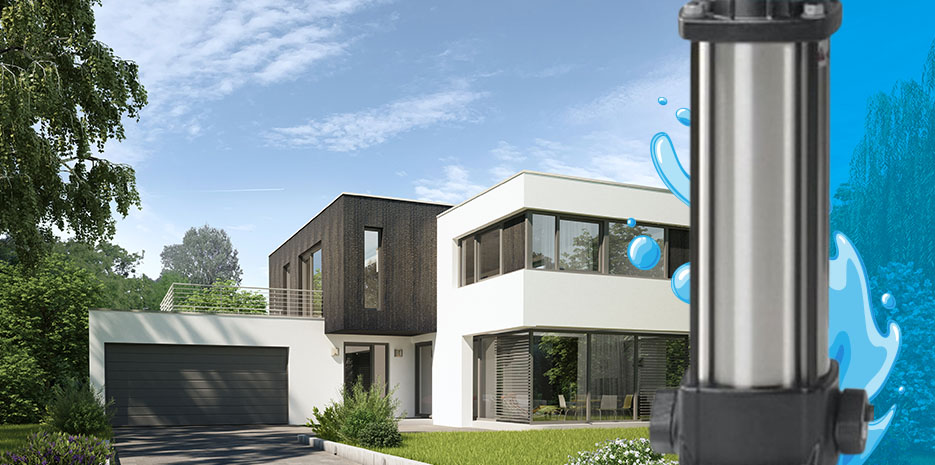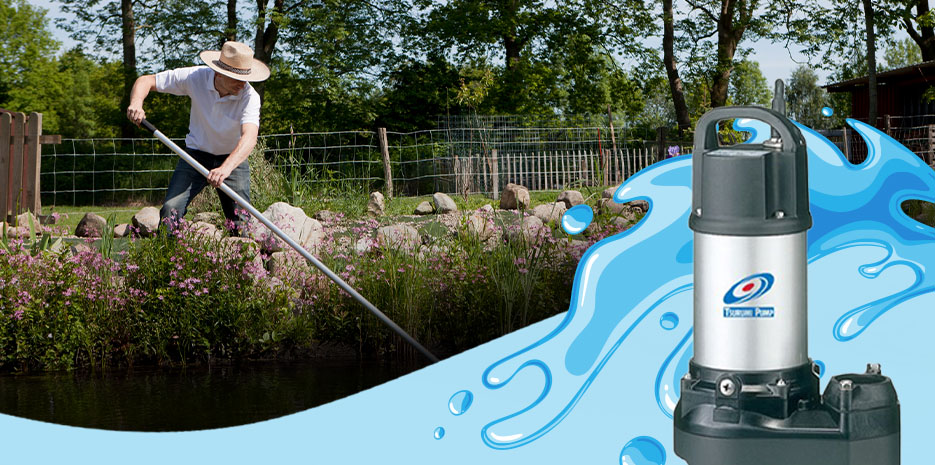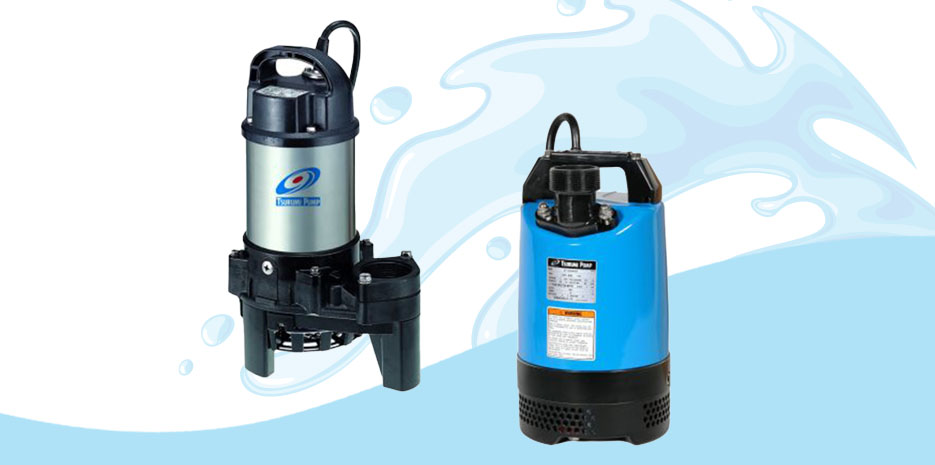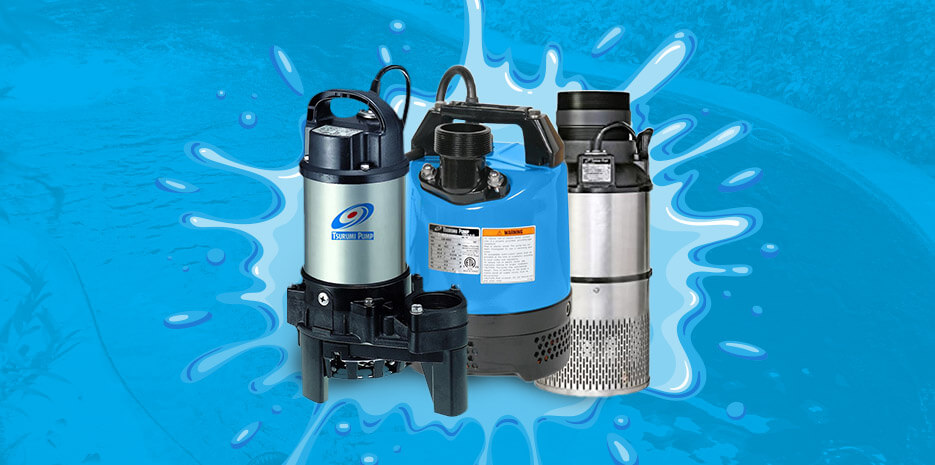Complete Pond Pump Buying Guide
- By Eli Weinstock
- Apr 9, 2024
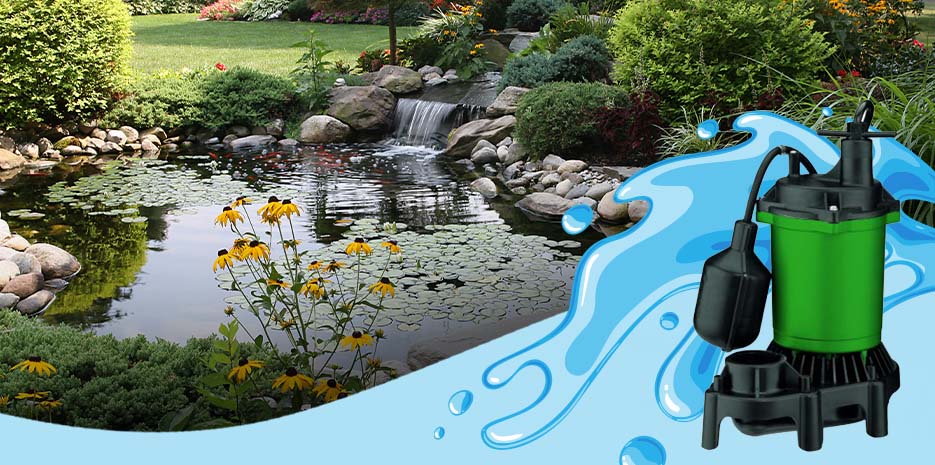
Ponds are beautiful features that add tranquility to any outdoor space. A healthy pond ecosystem with optimal oxygen can soon become a community of diverse animals and insects, enhancing the scenery at your home or business. The basis of that ecosystem is the pond pump, which provides circulation to power waterfalls, spread nutrients for fish and more.
Choosing the wrong pump can affect the health of your pond, causing algae growth and attracting mosquitos. To get the maximum use and benefits out of your pond pump, it's important to select one that's the right size and type. Use our guide to help you understand which pond pump to buy and narrow down your decision.
Common Types of Pond Pumps
Selecting the right pond pump is an important decision for proper circulation and a healthy pond. There are many different types of pond pumps available today, so learning about the capabilities and features of each one will help inform your search. We'll walk you through what the most common pond pumps are and in which situations they would be best suited.
1. Submersible Pumps
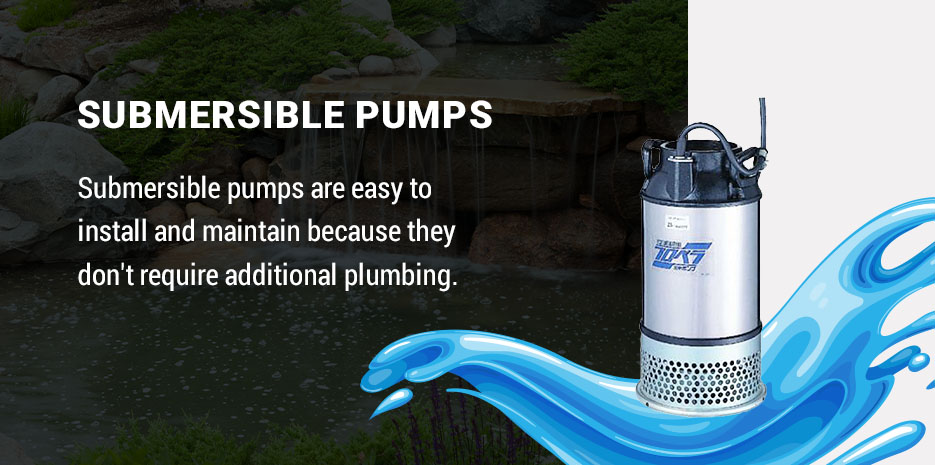
Submersible pumps are completely submerged in water and sit at the bottom of a pond. Because they are water-cooled, they can be used for 24/7 operation, but they will only work underwater. These types of pumps are ideal for small to medium-sized ponds and cannot be seen from the surface, making them suitable for natural settings. Submersible pumps are easy to install and maintain because they don't require additional plumbing.
They're also generally more energy-efficient and quieter than external pumps. Maintaining this pump is critical because it's more susceptible to water damage. Some submersible pond pumps can also be used to drain your pond and come in a range of sizes.
2. External Pumps
External pumps are designed for above-water installation. These pumps are ideal for larger ponds requiring higher flow rates to maintain waterfall features. An external pump can be housed outside the pond in a pump chamber and requires additional plumbing work to operate.
External pond pumps are relatively easy to maintain and offer excellent performance for circulating large volumes of water. These types of pumps are also durable, though their installation process is more complex than submersible pumps.
3. Solar Pumps
Solar pumps must be installed where they will get the most sun as they use solar energy to operate. These pumps are best for small ponds and fountains because they have lower flow rates. A solar pond pump requires full sun coverage, so these pumps may be more challenging to conceal.
However, solar pumps are a kind of external pump that does not require electricity or wiring, so they're easy to install and operate. They are also cost-effective and eco-friendly. Though these pumps won't work on cloudy days or at night, you can add an optional battery box, if desired, to supply continual power.
4. Centrifugal Pumps
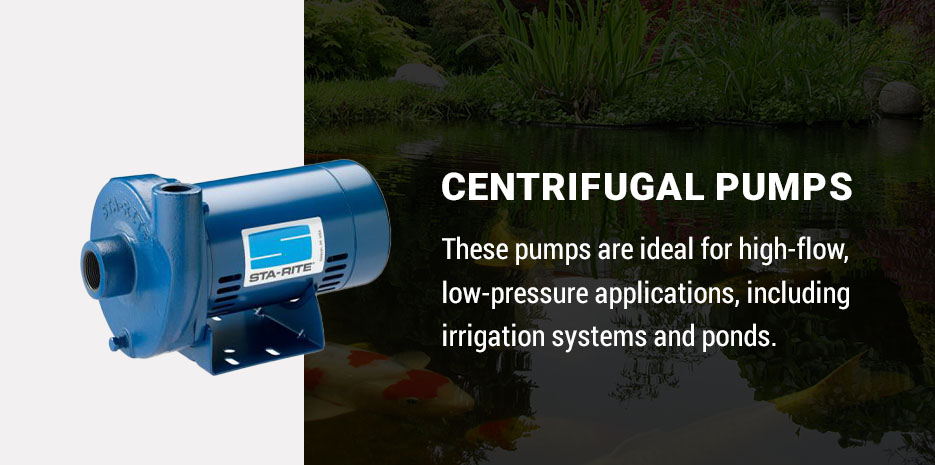
Centrifugal pumps maintain an efficient, steady water flow in a pond. These pumps are ideal for high-flow, low-pressure applications, including irrigation systems and ponds. As the name suggests, a centrifugal pump uses an impeller to produce a centrifugal force. This force pushes the fluid outward and moves it through the system. This pump can efficiently handle various fluids and viscosities.
5. Positive Displacement Pumps
Positive displacement pumps can produce reliable and consistent flow, even with high-viscosity fluids. This type of pump is also ideal for high-pressure applications because it ensures proper flow even with changes in viscosity or pressure.
6. Aeration Pumps
Getting adequate oxygen to your pond is essential for maintaining proper water quality and keeping plants, insects and animals healthy. Aeration pumps are placed on the outside of the pond to suck in air, compress it and propel it underwater. This process adds more oxygen to the water and reduces the likelihood of too much algae growth. An aeration pond pump may be ideal if your pond has lots of fish or plant life.
Considerations When Selecting a Pond Pump
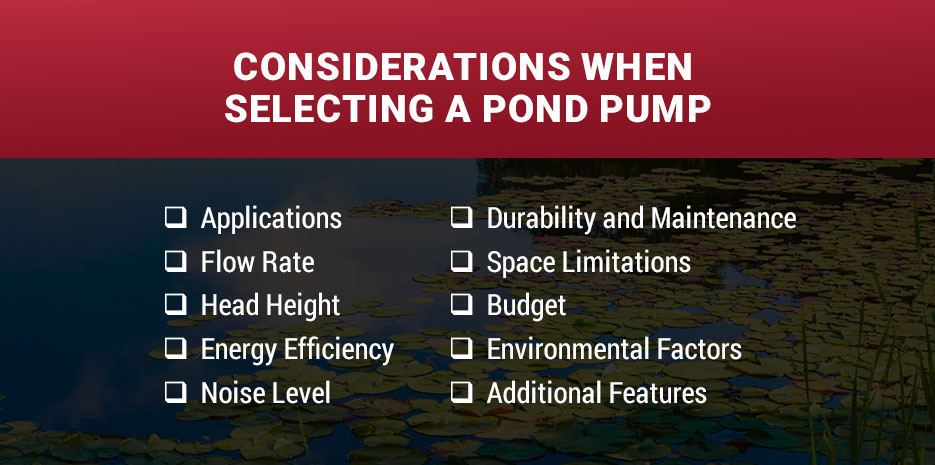
When choosing the right pump for your pond, there are several factors to consider to ensure the product meets your pump system requirements.
1. Applications
One of the first steps to picking out the best type of pond pump is to consider the application. What will you be using your pond pump for? Some pond pumps are purely functional, while others are decorative and help add to the visual appeal of your pond.
For instance, a small pond with a fountain feature may operate efficiently with a solar or submersible pump, but a large pond with a cascading waterfall will likely need something more heavy duty. If you have a pressure filter, you may have to buy a specific pump size that fits the manual recommendations. You might also be looking for a pump specifically for filtration, recirculation or aquatic features like plants and fish.
2. Flow Rate
The flow rate determines how much water a pump can circulate during a given time. The flow rate is generally measured in gallons per hour (GPH) or liters per hour (LPH). A general rule for ponds with plant life and fish is to turn over at least half of the volume of your pond every hour, or the entire volume within two hours.
For example, a 4,000-gallon pond requires a pump that can circulate at least 2,000 GPH for optimal aeration. If you have a lot of fish in your pond, It's usually recommended to double your flow rate if you have a high amount of fish in your pond or if the water is exposed to more debris. In these cases, your pond will need a higher flow rate for more filtration to keep it clean.
If you have fountains, streams or waterfall features, your pond pump should be capable of producing enough pressure to lift the water to your desired visual effect while still facilitating proper circulation. Your water features can often be the deciding factor in which pond pump best suits your needs.
3. Head Height
The head height, or head pressure, refers to how high a pond pump can lift the water from the surface. You'll need to consider head height if you have some type of water feature, including fountains or waterfalls. The right pump is pivotal in pushing out water efficiently and as high as you want it.
Every pump has a different flow rate, so their elevation capabilities will vary. If you want a better idea of how a pump will perform at different head heights, check the flow rate chart supplied by most pond pump manufacturers.
4. Energy Efficiency
Your pond pump's energy efficiency may be important to you for various reasons, including saving money on electricity bills or reducing your environmental impact. Energy-efficient pond pumps are a great option because they conserve energy and reduce operating costs over the long run. Some pond pumps will display a high energy efficiency rating to describe their energy consumption levels.
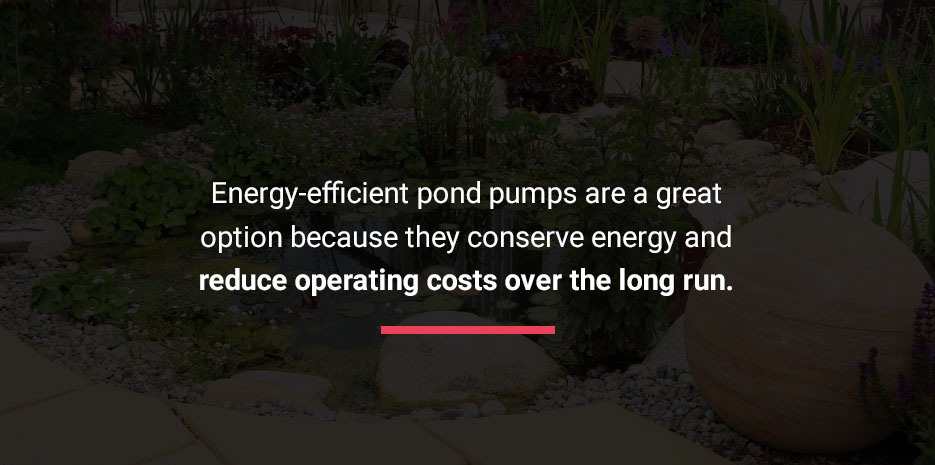
Additionally, some energy-efficient pond pumps can be powered by solar panels or come with adjustable speed motors so you can change the flow rate as needed. Pond pumps with features like timers or sensors can improve energy efficiency by automatically adjusting according to the water demand or temperature. Low-voltage pond pumps also use less energy and are considered safer for pond use as they reduce the risk of electric shock.
5. Noise Level
Whether your pond is a peaceful feature at your home or business, a loud pond pump can be distracting. The noise level of your pump system can even take away from the soothing sounds of running water. Keep in mind that low-voltage and submersible pumps tend to be quieter than high-voltage and external pumps.
6. Durability and Maintenance
Every pond pump requires maintenance from time to time. However, choosing from high-quality, specialized pumps with durable materials can minimize maintenance responsibilities and keep your pond healthy longer. Certain materials, such as ceramic or stainless steel, are less susceptible to wear and tear. Pond pumps constructed of these materials may have a longer service life. Additionally, look for pond pumps that can be easily cleaned.
7. Space Limitations
You may be limited to a certain number of pumps if your pond sits in a confined, small space. Some pump installation systems require much more space for maintenance and service, so it's important to measure the area to ensure you select the right type and size.
8. Budget
As with any purchase, you'll need to consider how much you're willing to spend on your pond pump. While you want a pond pump that meets your performance expectations, you'll also want to select the most cost-effective option. If necessary, you may also need to set a budget for installation costs.
9. Environmental Factors
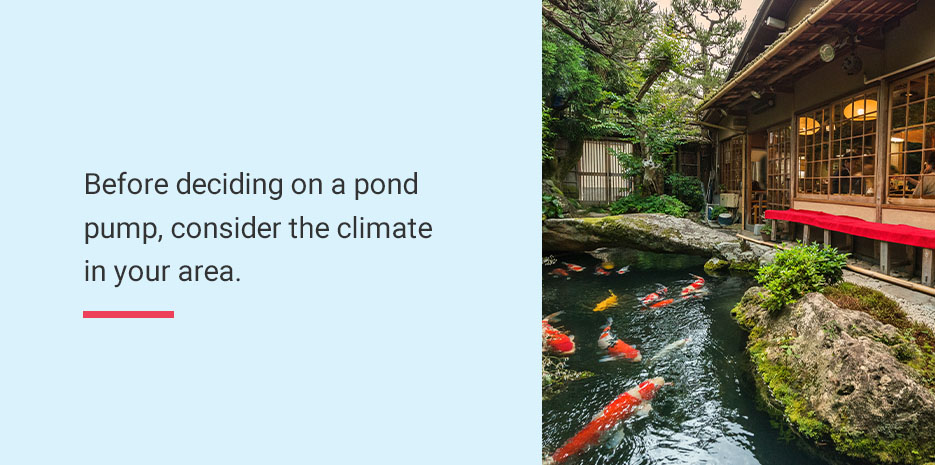
Before deciding on a pond pump, consider the climate in your area. Could your pond be affected by high humidity levels, corrosive elements or temperature fluctuations? These are just a few factors that can impact your pump's performance and longevity.
Check the environment ratings on different pumps to ensure they'll operate efficiently in your local environment. For added protection, you can also select a pump system with an enclosure or coating for weather resistance.
10. Additional Features
Some pump systems come with added features that boost performance, functionality and convenience, including:
- Adjustable flow control: Pond pumps with adjustable flow control features are particularly useful for energy efficiency. They're also beneficial for ponds that have various water features that require different flow rates, such as fountains or waterfalls. This feature allows you to customize the ambiance and water effects.
- Pre-filter: If you're looking for minimal maintenance, a pre-filter is an excellent, time-saving feature. Pre-filters act as a barrier to prevent large particles and debris, including twigs and leaves, from clogging your pond pump system. This feature makes maintenance and cleaning easier and reduces the risk of damage.
- UV clarifier: An ultra-violet clarifier helps reduce excessive algae growth in your pond. Using UV light, this feature minimizes water discoloration due to algae cells and maintains water clarity.
How to Choose the Right Size Pump for Your Pond
The right size pond pump is critical for proper filtration, circulation and efficiency. As mentioned, the top elements to consider for the appropriate pump size are:
- Head height
- Volume of water
- Flow rate
Whether you're installing the pump yourself or consulting a professional, knowing the dimensions of your pond can make the process much smoother. To calculate the volume of water in your pond, multiply the:
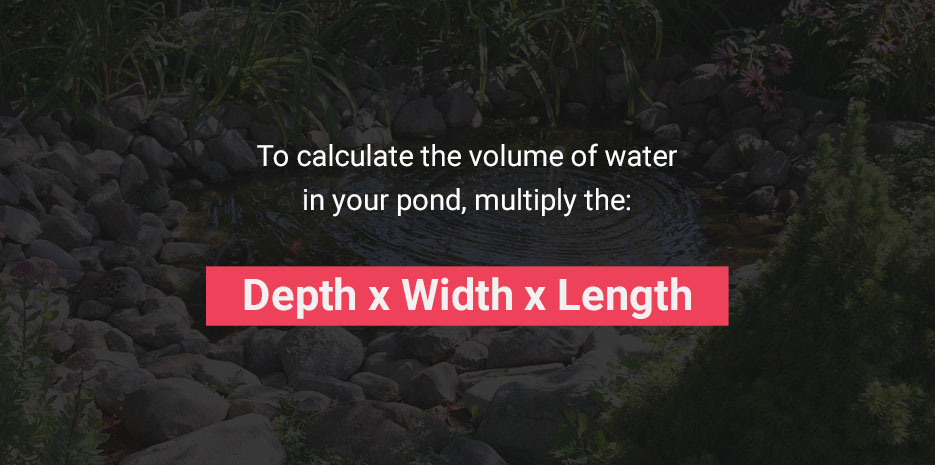
- Depth
- Width
- Length
If your pond has an irregular shape, split the area into sections and multiply them separately. If you have a waterfall, it's recommended to tack on additional volume. Measure the waterfall's dimensions, starting with the width of the stream and the height of the waterfall from the water's surface to the top. Keep in mind that a larger waterfall circulates more water, which means you may need a larger or additional pump. If your pond has a fountain, measure the height of the stream from the water's surface.
When you've calculated the volume, you can estimate your turnover rate. Next, measure the vertical distance from the highest point of water discharge to the water's surface — that's your head height. When you have both measurements, consult the pump system's manual for the flow rate chart to determine which pump size meets your requirements. In general, it's best to choose a pond pump with a slightly higher flow rate than needed so the system will remain efficient even with some clogging.
To calculate the additional flow rate you'll need for your waterfall or fountain, take the width measurement and multiply it by 100, 150 or 200 GPH, depending on how strong you want the flow to be. For example, say your waterfall is 10 inches wide, and you want maximum flow. Your calculation should look like this: 10 inches wide x 200 GPH = 2,000 GPH pond pump.
Best Practice and Preventative Maintenance Tips
Proper installation and maintenance are critical to keeping your pond pump in good shape. Here are some tips for extending the life span of your pump system and keeping your pond or water garden looking its best.
1. Lubricate as Necessary
Some pump systems may require lubrication from time to time to ensure all moving parts run smoothly. Check your pond pump's manual for the manufacturer's recommendations to determine if your system requires lubrication and how often you should use it.
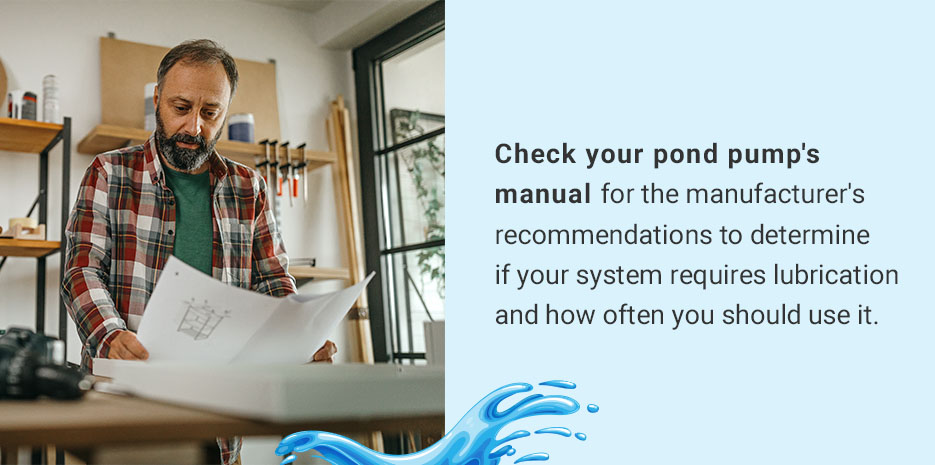
2. Check for Damage
As with any mechanical or electric component, your pond pump can decrease in efficiency if not properly maintained. It's recommended to regularly inspect your pond pump's components for corrosion and clean out any blockages or debris buildup. Be sure to clean the pre-filter, inspect the plumbing for signs of wear and replace any damaged or worn parts.
Inspecting the system can help you identify issues and promptly address them before they affect the health of your pond and aquatic life. Checking your components often, such as the pump's impeller, will also keep excessive clogging at bay and prevent damage. Additionally, keep an eye on your pump's energy consumption. A sharp increase or decrease could indicate an issue. These periodic checks will ensure optimal performance.
3. Select a High-Quality Pump With a Guarantee
Pond pumps are designed to collect dirt, bacteria and debris from your pond and the surrounding plant life. You'll want to select a pond pump made of quality materials that can withstand such conditions. A pond pump system that comes with a guarantee will usually indicate its sturdiness and longevity.
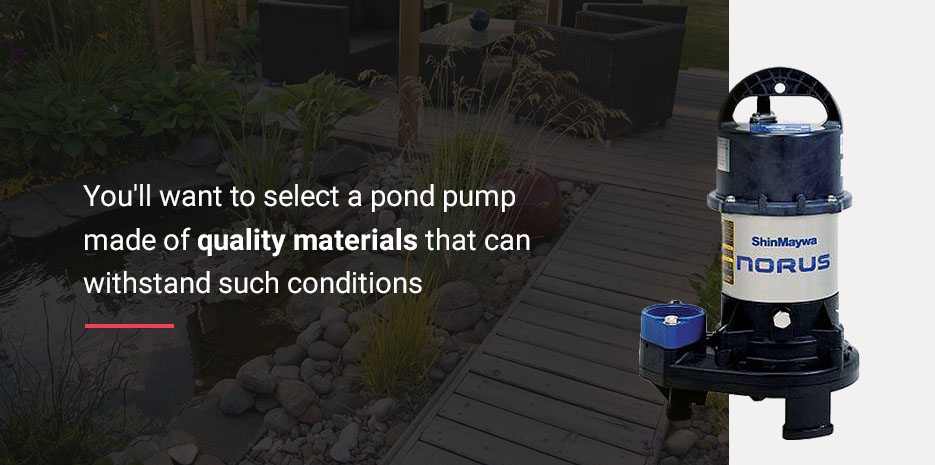
4. Determine if You Require Around-the-Clock Pumping
Solar pumps are ideal for conserving energy, but they may not be ideal for certain ponds. If you have fish in your pond, you'll need a pump that runs 24/7. While having a battery box as a backup can be helpful for nighttime or overcast days, it's not the most practical solution. To prevent bacteria and debris from quickly growing and harming your fish, you need a pond pump that can run all hours of the day and night without fail.
5. Keep a Backup on Hand
No matter what type of pond pump you choose, it can give you some peace of mind to know you always have a backup solution available. If your pond pump fails or becomes damaged, fast-growing bacteria can quickly affect the health of your fish. Waiting too long to get a new pump can exacerbate the situation, so it's always best to have a replacement.
Common Pump Issues and Solutions
Over the service life of your pond pump system, you may encounter problems that leave your water looking dirty or create a noticeable difference in efficiency. Here are some potential issues that can arise and troubleshooting solutions to try:
- Leakage: Damage to the seal or improper installation can lead to visible leaks around your pump seals. If you notice reduced efficiency and performance, it may be due to a seal leakage causing fluid to escape the pump. Ensure your pump is correctly installed and aligned. If this is not the cause, you may need to replace the worn or damaged seals.
- Misalignment or vibration: Your pump may produce unusual noises or move excessively during operation. This may be caused by a misalignment between the pump and the drive shaft, causing the pump to vibrate and potentially lead to premature wear and tear on the components. An improperly balanced impeller or rotor may also cause excessive vibrations. Realign the pump or balance the impeller to get it back to performing efficiently.
- Cavitation: Your pump components can become damaged if the pressure drops below the vapor pressure of the fluid. This can create bubbles that eventually implode and cause reduced flow or unusual noises, such as grinding or popping. Blockages in the suction line or insufficient net positive suction head may cause this problem. Inspect and clean the suction line or adjust your system's parameters to resolve the issue.
Find High-Quality Pond Pumps From ePumps
Selecting the right pump for your pond is key to maintaining water clarity and the health of your fish. At ePumps, we pride ourselves on helping our customers find the best pond pump for their needs. We recognize the challenges of choosing a pond pump and filter that works for your water feature.
For over 20 years, we've provided exceptional customer service and offerings to help our customers decide between pump types and learn installation techniques. If you're searching for a pump for your pond, you can rely on our extensive pump industry experience and ongoing support. Browse our catalog today to view our products from top manufacturers, and contact us at (844) 378-6771 if you have any questions.

